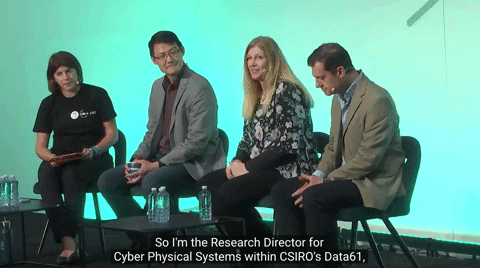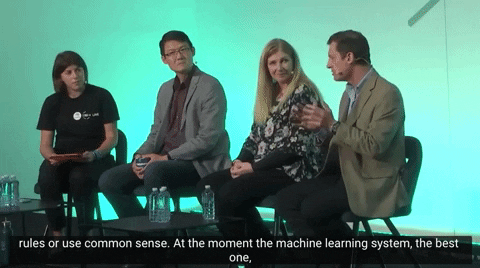On October 2nd 2019, a panel of artificial intelligence and machine learning experts from CSIRO’s Data61 discussed the myriad of applications, benefits and challenges AI presents to the nation and the world at D61+ LIVE 2019, Australia’s premier data science event.
According to Data61’s Digital Innovation Report developed by AlphaBeta, digital innovation, underpinned by science and technology, has created enormous value globally and now accounts for 11 per cent of GDP in advanced economies. As stated by the report, Artificial Intelligence presents a significant opportunity for Australia, and if we seize the opportunities artificial intelligence has presented, we can unlock $315 billion in gross economic value over the next decade.

Artificial Intelligence (AI) is the name given to a range of technologies that exhibit some characteristics of human intelligence. The benefit of AI is not that it can behave like humans can, instead it is about using it to complete a task more efficiently.
There are many fields of science within AI including: machine learning, cyber-physical systems, robotics, deep learning, and computer vision and imaging, just to name a few. All of these come together to create breakthrough technology.
“I’d like to think of cyber-physical systems as just a flash way of saying that we work with bringing the digital and the physical together,” explained Dr. Sue Keay, Research Director of Cyber Physical Systems group. “The type of research that happens within my program includes robotics and autonomous systems, distributed sensing systems, imaging and computer vision, and cybernetics, and all those things can be applied across different industry sectors, so it's just fascinating to see where a lot of this technology might take us.”
Machine learning, a technology often characterised as AI, is used to make predictions and conclusions based on data. Machines do not 'learn' as humans do. But they can be engineered to adapt to complex changing environments.

“As science becomes more data intensive, we're starting to use machine learning more and more, to analyse the scientific data sets and to use machine learning to make predictions,” said Dr. Cheng Soon Ong, Principal Research Scientist within Data61 Machine Learning group.
“Machine learning is all about predictions. We write programs that learn to improve themselves using vast amounts of data. A simple example is using your genome to make a prediction about your risk of disease,” he continued.
Image analysis is also a core part of AI and plays an important role across industries. It can be used in conjunction with autonomous vehicles, surveying deserts, or determining safe environments for people to work in. At the same time, this technique can be applied to understand human behaviours.
“Take the hospitality industry, for example,” said Dr. Olivier Salvado, Group Leader Computer Vision and Imaging. "We can detect how many customers enter a restaurant at any given time or map workers in a factory moving sensitive assets. Agriculture uses a lot of computer vision to estimate yield of crops, move tractors autonomously, and to understand the science behind the plants and the food that we are eating." - Dr Olivier Salvado, Group Leader Computer Vision and Imaging
Quantifying medical radiology is another substantial area where AI can have a huge impact.
Radiologists have traditionally compared vast amounts of medical images produced by MRIs and PET and CT scans to diagnose conditions - a time-intensive and complex process.
“All those tasks can be quantified by AI to support and aid the radiologists,” said Olivier. “It can free up their time to do the more interesting stuff and to increase the number of people that can use the technology.”
And as robotics is becoming increasingly more pervasive, we’re starting to see commodity products turned into robots.
“It’s about how we can work with what is actually already have in existence and making it serve a useful function just by turning it autonomous,” Dr Sue Keay, Research Director of Cyber Physical Systems group.
“Imagine having shopping cards that are automated instead of being pushed by humans and equipped with sensors, so you don’t have to reconfigure your store.
“At the moment we use what we call AGVs or ‘automated guided vehicles’ and typically each unit would cost about $100,000 at minimum. Then, you'd have to design your factory, warehouse or your logistic space to suit that AGV. Whereas, if you could just make the material and existing equipment in your warehouse into robots you can imagine the productivity boost.”
This approach could also have a great benefit to Australia’s ageing population by utilising automated technology to make elderly people’s lives easier.

“I think that we're going to see a transition from home assistance into companion robots. All that is needed is to make your home assistant vision enabled with some of the technologies that Oliver talked about and then making them mobile, so that they can be moving around the house to keep an eye on things,” continued Sue.
This could soon lead us to a new challenge - how we respond emotionally to our robot helpers and other technology, and whether we can trust the technology and its data.
“Trust is an important aspect of Machine Learning,” said Cheng. “You need to be able to understand what the machine learning algorithm is predicting and the confidence level of that prediction, so that it helps us make good decisions. “
The majority of machine learning that is currently employed is overseen by humans, who use large datasets to train computer systems to recognise a pattern within the information. When new data is presented to the system after training, it is able to tell you which category it most likely belongs to.
“The issue is that the computer cannot use common sense,” said Olivier. For example, if you take a teenager that has spent 10 hours learning how to drive, they would be able to apply that knowledge or data in another context, such as driving in another country. Whereas you wouldn’t trust a program that ‘taught’ a driverless car to drive in Sydney with letting it drive on the right side of the road, say in Germany, although the same principles apply, explained Olivier.
“So, there is a big gap between what computers can actually do and people’s expectations. Trust would come when perhaps, we reach the next level of intelligence where the system would understand the basic rules or use common sense.”
To reach that level of machine learning “common sense”, a great deal of research and development is still required, with machine learning requiring exponential amounts of data to be trained, all of which needs to be gathered and segmented.
Another critical ingredient is what’s known as “a ground truth,'' explained Olivier. How do we train an algorithm model if we don't have the underlying absolute ground truth? Unlike humans, machines cannot use their ‘gut feeling’.
The fundamental question is what is learnable and what are the limits of learning. It’s a big challenge research is trying to unpack.
Watch the full discussion below:
